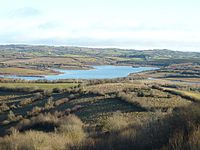Sillees River: Difference between revisions
No edit summary |
No edit summary |
||
| Line 1: | Line 1: | ||
{{county|Fermanagh}} | |||
[[File:Cloghbane Bridge - geograph.org.uk - 487503.jpg|right|thumb|350px|Cloghbane Bridge on the Sillees]] | [[File:Cloghbane Bridge - geograph.org.uk - 487503.jpg|right|thumb|350px|Cloghbane Bridge on the Sillees]] | ||
The '''Sillees River''' flows | The '''Sillees River''' flows through south-west [[Fermanagh]]. Its origins lie in Lough Ahork, which is located in Lough Navar Forest | ||
The interesting name 'Sillees' is from the Gaelic ''Abhainn na Sailchis'' meaning "the sally kesh river" | The interesting name 'Sillees' is from the Gaelic ''Abhainn na Sailchis'' meaning "the sally kesh river" | ||
| Line 18: | Line 19: | ||
The Sillees River has the distinction of having a species of brachiopod named after it, namely ''Rugosochonetes silleesi''.<ref name=habitas-sillees>{{cite web |author=Simms, Michael J. |title=Carrick Lough, Bunnahone Lough and the Sillees River |publisher=Northern Ireland Environment Agency |url=http://www.habitas.org.uk/escr/site.asp?Item=112 |accessdate=2009-05-03}}</ref> Indeed, some 56 species of early Carboniferous brachiopods alone were discovered in this area as well as 69 species of bryozoans.<ref name=habitas-sillees /><ref>{{cite journal |title=Silicified Brachiopods from the Visean of Fermanagh (II) |volume=Geology Volume 16 |issue=i |author=Brunton, C.H.C. |publisher=British Museum of Natural History |journal=Bulletin of the British Museum |year=1968 |url=http://www.archive.org/stream/bulletinofbritis16geollond/bulletinofbritis16geollond_djvu.txt}}</ref> | The Sillees River has the distinction of having a species of brachiopod named after it, namely ''Rugosochonetes silleesi''.<ref name=habitas-sillees>{{cite web |author=Simms, Michael J. |title=Carrick Lough, Bunnahone Lough and the Sillees River |publisher=Northern Ireland Environment Agency |url=http://www.habitas.org.uk/escr/site.asp?Item=112 |accessdate=2009-05-03}}</ref> Indeed, some 56 species of early Carboniferous brachiopods alone were discovered in this area as well as 69 species of bryozoans.<ref name=habitas-sillees /><ref>{{cite journal |title=Silicified Brachiopods from the Visean of Fermanagh (II) |volume=Geology Volume 16 |issue=i |author=Brunton, C.H.C. |publisher=British Museum of Natural History |journal=Bulletin of the British Museum |year=1968 |url=http://www.archive.org/stream/bulletinofbritis16geollond/bulletinofbritis16geollond_djvu.txt}}</ref> | ||
==References== | |||
{{commons}} | {{commons}} | ||
= | *Location map: {{wmap|54.333333|-7.633333|zoom=14}} | ||
{{reflist}} | {{reflist}} | ||
[[Category:Rivers of Fermanagh]] | [[Category:Rivers of Fermanagh]] | ||
Latest revision as of 11:37, 16 June 2017

The Sillees River flows through south-west Fermanagh. Its origins lie in Lough Ahork, which is located in Lough Navar Forest
The interesting name 'Sillees' is from the Gaelic Abhainn na Sailchis meaning "the sally kesh river"
From its source in the Lough Navar Forest, the river tumbles down through Correl Glen, Derrygonnelly and the Boho countryside passing through both Carran and Ross Loughs where it ends in Lower Lough Erne.[1][2]

There are a few tributary streams and rivers that flow into the Sillees river, amongst them, the Boho River, the Screenagh which emerges from the Arch cave and the Reyfad stream which enters Pollytullybrack of the Reyfad cave system.[3]

Folk tales associated with the river
The river is famous for the curse which was given by St Faber; legend says that she changed the direction of the river, making the river bad for fishing and good for drowning.[4]
In another tale of the river, there is a Highwayman known as Black Francis Corrigan, who leaps the Sillees in a single bound with his horse after a famous robbery.[5]
Geological and palaeontological interest
The Sillees River has the distinction of having a species of brachiopod named after it, namely Rugosochonetes silleesi.[6] Indeed, some 56 species of early Carboniferous brachiopods alone were discovered in this area as well as 69 species of bryozoans.[6][7]
References
| ("Wikimedia Commons" has material about Sillees River) |
- Location map: 54°19’60"N, 7°37’60"W
- ↑ "The Sillees Valley Geodiversity Profile". Northern Ireland Environment Agency. http://www.ni-environment.gov.uk/land-home/landscape_home/country_landscape/7/7-geo.htm. Retrieved 2009-05-03.
- ↑ "Lough Navar Forest". Department of Agriculture and Rural Development, Forest Service. http://www.forestserviceni.gov.uk/index/forests-in-northern-ireland/forests-in-the-west-district/lough-navar-forest.htm. Retrieved 2009-05-03.
- ↑ "Earth Science Conservation Review". National Museums Northern Ireland. http://www.habitas.org.uk/escr/summary.asp?item=1161.
- ↑ Glassie, Henry (1998). Irish Folk History: Tales from the North. University of Pennsylvania Press. p. 176. ISBN 9780812211238. http://books.google.com/?id=-eRxZbkyMp4C&pg=PA100&lpg=PA100&dq=Henry+Glassie+fermanagh.
- ↑ Henry H. Glassie, Doug Boyd (2006). The stars of Ballymenone. Published by Indiana University Press. pp. 574. ISBN 9780253347176. http://books.google.com/?id=zc38K7nSW-kC&pg=PA283&lpg=PA283&dq=stars+of+ballymenone+black+francis+corrigan.
- ↑ 6.0 6.1 Simms, Michael J.. "Carrick Lough, Bunnahone Lough and the Sillees River". Northern Ireland Environment Agency. http://www.habitas.org.uk/escr/site.asp?Item=112. Retrieved 2009-05-03.
- ↑ Brunton, C.H.C. (1968). "Silicified Brachiopods from the Visean of Fermanagh (II)". Bulletin of the British Museum (British Museum of Natural History) Geology Volume 16 (i). http://www.archive.org/stream/bulletinofbritis16geollond/bulletinofbritis16geollond_djvu.txt.
